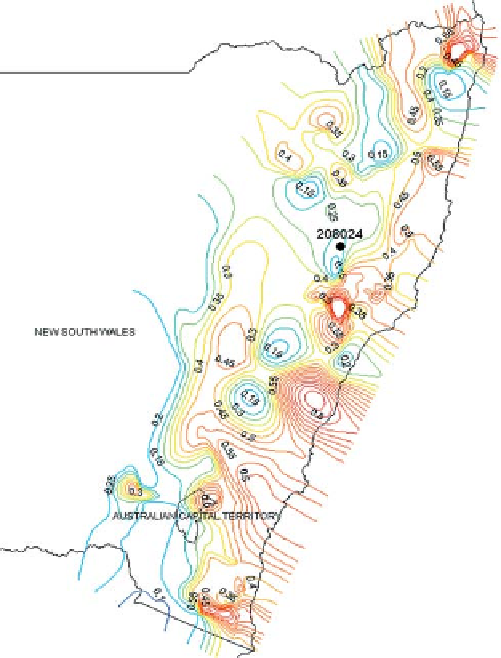Geography Reference
In-Depth Information
Q
T
¼
C
T
I
T
,
tc
A
ð
9
:
3
Þ
where A is the area of the catchment, and I
T,tc
is the annual
maximum rainfall intensity with a return period T averaged
over duration t
r
(t
r
is chosen to be equal to the mean
response time t
c
of the catchment), and C
T
is an apparent
runoff coefficient. In reality C
T
is really a conversion factor
that transforms the average rainfall intensity I
T,tc
to the
flood peak Q
T
of return period T. So, in a sense the rational
formula stands for the entirety of the rainfall
flood
peak model used here (combining the runoff generation
part and the runoff routing part). The choice of t
r
¼
-
runoff
-
t
c
reflects the nature of the simplest possible runoff routing
model used, which assumes that the highest flood peak is
produced under resonance conditions. The rational method
has survived numerous criticisms regarding its over-
simplification of the rainfall
runoff transformation, and it
is still one of the most widely used approaches by practi-
tioners around the world to estimate design floods, particu-
larly in small ungauged basins (Australian Rainfall and
Runoff,
1987
; Brath et al.,
2001
; Jiapeng et al.,
2003
;
Pegram and Parak,
2004
).
The manner in which the rational method is made
applicable for predictions in ungauged catchments is quite
instructive. The IDF curves that go into the method are
estimated for the region of interest from available rainfall
data, and therefore are regionally applicable. Flood predic-
tions at a range of return periods produced by the rational
method are conditioned (e.g., calibrated) on flood fre-
quency data at a number of gauged catchments in the
region. In other words, the runoff coefficients C
T
are esti-
mated for all gauged catchments in the region as a function
of return period T. Once this is done, regional averages of
these C
T
values can be estimated, which can then be
adopted for any ungauged basin in the region. Alterna-
tively, if considerable flood data exist in the region, then
regional relationships of the runoff coefficients can be
generated in terms of measurable climatic and catchment
characteristics, which can be used to interpolate between
the gauged catchments. In this way, the method ensures
that the predictions are grounded in observed data, and
over time there is accumulation of knowledge that continu-
ously improves the accuracy of predictions by the rational
method in ungauged basins in the region. The output
from such a regional data-based approach is illustrated by
Figure 9.18
, which shows a map of the 10-year runoff
coeffi
cient for eastern New South Wales, Australia. The
runoff coefficients were obtained from a regional analysis
using gauged data and catchment characteristics. It is
worth noting that Rahman et al.(
2011b
) compared this
approach against a fixed-region quantile regression
approach and showed the regression approach was
preferred.
-
Figure 9.18. Map of regionalised runoff coefficients of the rational
formula C
10
values (see Equation 9.3) for eastern New South Wales,
Australia. From Rahman et al.(
2011b
).
Process-based methods that will be surveyed in the
forthcoming sub-sections are considerably more advanced
in terms of the physical realism of the rainfall
runoff
model used. Nevertheless, the key factor in all methods is
how the principles illustrated above with respect to the
rational method are followed. The link to regional flood
frequency data and the use of appropriate parameter values
that are conditioned on such data will be the weakest link
in these more advanced process-based methods.
-
9.4.1 Derived distribution methods
Two kinds of derived distribution methods are distin-
guished here. The first class of methods is the design storm
methods, commonly used in engineering practice, which
are similar to the rational method discussed above, even
though they take into account processes in a more explicit
way. In the design storm method the flood peak arising
from a single storm is estimated. The second class of
methods estimates the entire population of flood events.
These methods have been developed by the scientific

Search WWH ::

Custom Search